
Who Were
The Cambs
The Cambs
at War
1/1st Btn 1914-1919
1914 - 1/1st Overview
1915 - 1/1st Overview
1915 - St Eloi
1915 - Fosse Wood
1916 - 1/1st Overview
1916 - The Schwaben
1916 - St Pierre Divion
1917 - 1/1st Overview
1917 - St Julien
Insignia, Medals & Books
Remembering The Cambs
Biographies
About Us &
This Site
Somain and a Triumphant Return Home - 12th November 1918 to 21st May 1919
Home Away from Home - Somain
The days following the Armistice saw the Cambridgeshires continue with their unglamorous task of road repairs, slowing moving between the numerous villages in the area now known as the Scarpe-Escaut Regional Nature Park. The first real glimpse of life after the ceasefire for the men was on November 17th when a Thanksgiving Dinner was held at Bon-Secours, followed four days later by a Battalion inspection by Brigadier General Vincent CMG on the village football pitch. A few days later, on November 26th, the Battalion moved into billets in Somain - a village that was to become the Cambridgeshires’ home for the next five months.
Life at Somain soon settled down into a combination of training, battlefield clearance, salvage work and guarding the nearby railway sidings. Throughout December there were also numerous parades where some of the officers and men that had been put forward for gallantry medals during the closing months of the war were presented their medal ribbons. One important task that was carried out as soon as it was clear the ceasefire was lasting was the retrieval of the Battalion’s Colours. These two Colours (the Regimental Colour and the King’s Colour) had been placed in Greater St Mary’s Church in central Cambridge in the opening weeks of the War for safekeeping. The Colour Party that went to retrieve them returned to the 1/1st Battalion on December 13th and, from then on, the Colours took pride of place at all the parades and ceremonial events that the Cambs participated in.
On January 17th the award of the 1914/15 Star ribbon for all those entitled was announced. Amazingly there were around 220 men serving with the Battalion at this date who were entitled to the ribbon and it was soon worn with pride by these “old sweats”. Further recognition for many of the seasoned or decorated Cambridgeshires came in February when many of them were hand picked to serve as part of the guard during a visit by the Prince of Wales.
Sports and competitions quickly became an important way of keeping the men motivated and entertained and numerous matches and events took place with neighbouring units. Football, rugby, boxing and tug of war matches were frequent and the Battalion’s Drums took part in several competitions, winning the 8th Corps Championship and finishing second in the 1st Army competition.
For some who had been serving overseas for many months or years there was the chance to get a leave pass and return home for a short time. Other men were able to get a special two-day leave pass to visit nearby Lille. On several known occasions some of the Battalion’s officers, accompanied by a handful of other ranks, chose to take road trips to visit some of the battlefields where they had fought. One such visit was to the Ypres salient, including to the site of the Battalion’s stand at St Julien and later attack on Tower Hamlets. Another visit, which was carried out by the Battalion’s Adjutant, Capt “Jerry” Walker, and Capt “Chick” Warren, was to the sites of some of the fierce battles of August and September 1918. During this trip Warren was able to locate and place a named cross on some unnamed graves, as well as visiting and photographing the site of the Battalion HQ where his close friend, Lt Col Saint DSO, had been mortally wounded.
Despite the relative peace there was still serious work to undertake - the nearby railway line and station at Somain acted as a vital and busy marshaling yard and sidings for trains travelling to and from the Cologne bridgeheads. At night these static goods trains attracted considerable attention from looters and so a guard of up to 125 armed officers and men was required. Sadly as noted by Clayton in the regimental history these guards were forced to fire on looters on several occasions. Another officer noted that such incidents with looters were commonplace and while chasing off French civilians almost became a game, when it came to trying to stop armed Australian soldiers it was quite another matter.
Demobilization of men from the Battalion started on December 12th when a draft of eight men, all coal miners by trade from Leicestershire and Nottingham, left to return to England. These drafts of men leaving for demobilization became a daily occurrence in January 1919, with handfuls of men leaving most days. Over the course of the month a total of nearly 200 men left the Battalion. February saw this rate continue to accelerate with 240 leaving for demobilization, in addition, a further 130 men (including two officers) were transferred over to the 11th Battalion, Suffolk Regiment, who were now serving as part of the Army of Occupation on the Rhine. March saw further small reductions and by the end of the month Battalion strength was just under 100 officers and men. By the end of April only a Cadre, consisting of 11 officers and 48 other ranks, remained.
Finally, on May 6th, nearly six months after the Armistice was signed, the Cadre of the 1/1st Battalion left Somain and started a slow journey home. On May 9th they reached Dunkirk, where the Battalion’s stores and transport were loaded onto the SS Clutha. The following day the Cadre boarded the steamer the Michael Sidirov and crossed the channel. By total coincidence one of the other cadres on the steamer was the 1/1st Cambridgeshires’ old comrades from the 118th Brigade, the 4/5th Black Watch, and a joyous (and flat calm) crossing was enjoyed by all. Again by odd coincidence the steamer arrived at Southampton, docking in exactly the same quay where the Battalion had left in February 1915.
The Cadre’s journey home was paused for two weeks at Sandling Camp, where the remaining equipment and stores were sorted and handed over. Back in Cambridge news of the Battalion’s journey home was being closely followed and plans were made for their triumphant return. Finally on the morning of May 21st the Cadre boarded a train and began their final journey as the 1/1st Battalion, Cambridgeshire Regiment.
Welcome Home - The Return to Cambridge
After a slight delay during the train journey, the Cadre pulled into Cambridge Station at 12.34pm on Wednesday, May 21st 1919, where it was met by cheering crowds. Large numbers of local dignitaries, officers, former comrades, relatives and local residents greeted them as the band of the 1st Cambridgeshire Volunteer Regiment played. In the station yard the Cadre lined up and was inspected by the Lord Lieutenant, Mr Adeane, and following this his wife tied victory laurel wreaths to the two Colours. With the crowds cheering around them, the men formed up behind the Drums and began their march through Cambridge, followed by many of their former comrades.
With the bells of the Catholic Church ringing out, the men marched down Station Road and along Hills Road, Regent Street and St Andrews Street, after which they turned on to Petty Cury and entered the Market Place. Crowds had lined the route but the market was packed with even more cheering and singing locals. After marching around the right-hand side of the market, the procession passed Greater St Mary’s and moved on to King’s Parade and entered King’s College. From here they went down Queen’s Road and along Burrell’s Walk before finally arriving at the 1st Eastern General Hospital where a lunch had been arranged.
After the lunch there were numerous speeches and toasts detailing many of the gallant deeds and places where the Cambs had fought and tribute was paid to the many who had been lost and the many more who had been wounded. After the speeches there was a concert and afternoon tea. Finally at around 5pm the Cadre formed up once again and marched to the Drill Hall on East Road. Despite an offer from Lt Col Clayton of leaving that evening, all the men of the Cadre elected to stay overnight and leave in the morning. Their last evening together was spent as guests of the New Theatre on St Andrews Street after which the men returned to the Drill Hall for the night. The following morning the men were discharged and with that the 1/1st Battalion, Cambridgeshire Regiment became history.
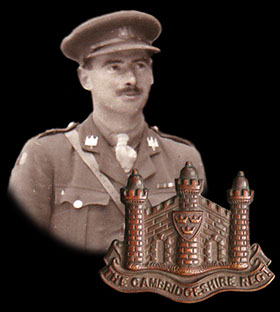
Lt Col Clayton DSO while at Somain.
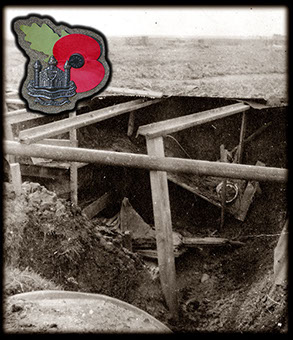
Photo of where Lt Col Saint was mortally wounded, taken by Cambs officers in 1919.
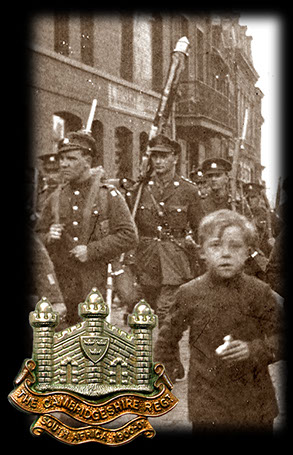
The Cadre leaving Somain, 6th May 1919.
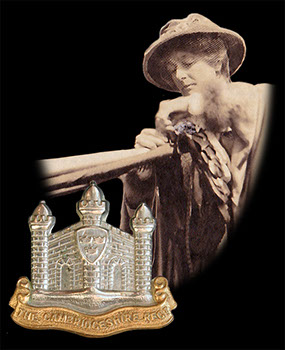
Mrs Adeane attaching the victory wreath.
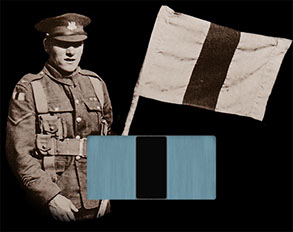
The Cambs Btn HQ flag at the 1st Eastern General Hospital on 21st May 1919.

This site went live on the 14th February 2015 to mark 100 years since the 1/1st Cambs went off to war.
WE WILL REMEMBER THEM
Email us: cambsregt@gmail.com
Copyright 2015, 2016, 2017, 2018, 2019 by Felix Jackson. The information and images on this site should not be reproduced without prior permission.